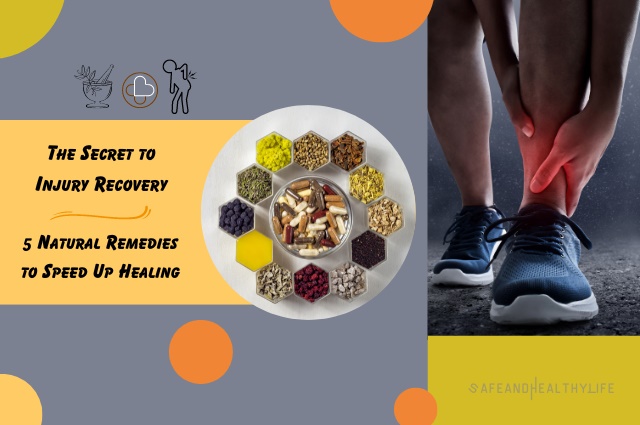
Natural treatments can bolster the body’s innate healing mechanisms and expedite injury recovery.
We will introduce five natural remedies that can significantly enhance your healing journey.
Whether you’re contending with a sprained ankle, a strained muscle, a fracture, or any other injury necessitating prompt recovery, rest assured we have the solutions you need.
Uncover the power of rest, the wonders of herbal remedies, and the skill of bolstering your body’s natural healing abilities for a quicker-than-ever recovery.
Together, we’ll unveil the keys to accelerated healing and guide you toward your well-being journey.
5 Natural Remedies to Recover From an Injury Faster
Here are 5 natural remedies that can help speed up recovery from an injury:
1. Herbal Supplements
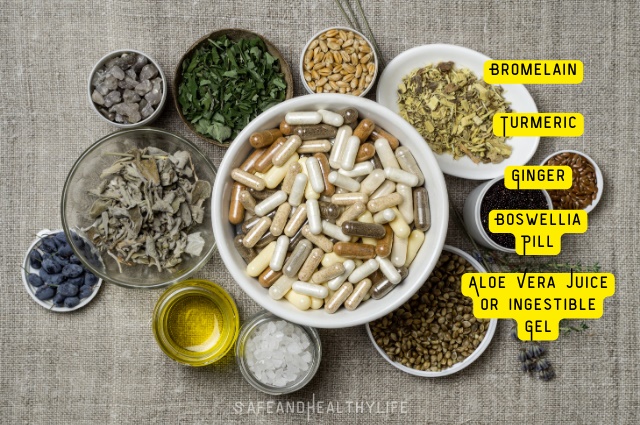
These supplements are derived from plants and herbs that have been used for centuries in traditional medicine. Herbal supplements promote healing and reduce inflammation.
1. Bromelain
An enzyme found in pineapple stems and fruit is called “Bromelain.” It has been studied for its potential health benefits.
- Reduces inflammation
- Relieves pain
- Improves blood circulation
- Regulates and modulates the immune system
- Helps reduce the formation of excessive scar tissue
2. Turmeric
Due to its therapeutic qualities, turmeric has long been utilized in traditional healing practices like Ayurveda and traditional Chinese medicine. The active ingredient within turmeric, known as curcumin, is thought to be the contributor to its health advantages.
- Reduces inflammation
- Relieves pain
- Reduces oxidative stress
- Enhances tissue repair and regeneration
- Regulates and modulates the immune system
- Improves blood circulation
3. Ginger
This is a popular spice with a long history of medicinal use, particularly in traditional medicine systems. It contains bioactive compounds such as gingerol, contributing to its health benefits.
Ginger supplements and extracts help speed up recovery from injuries.
- Reduces inflammation
- Relieves pain
- Improves digestive support and alleviates gastrointestinal discomfort
- Promotes muscle relaxation in the affected area
- Reduces oxidative stress
- Improves blood circulation
4. Boswellia Pill
Also known as Boswellia supplements or Indian frankincense extract, boswellia pills contain active compounds called Boswellic acids. These pills are derived from the resin of the Boswellia serrata tree and have been used in traditional medicine for their medicinal properties.
- Reduces inflammation
- Relieves pain
- Enhances tissue repair and regeneration
- Protects the cartilage and maintains joint health and function
- Reduces oxidative stress
- Regulates and modulates the immune system
5. Aloe Vera Juice or Ingestible Gel
Aloe vera can also be used as an herbal remedy to promote faster injury recovery. Aloe vera juice or ingestible gel can be taken daily to enhance the body’s natural healing mechanisms and accelerate recovery.
When consumed orally, aloe vera can:
- Helps boost the immune system
- Reduces inflammation
- Enhances tissue repair and regeneration
Including these herbal supplements in your healing regimen can help speed up recovery and get you back on your feet more quickly.
(Remember that if you have any existing conditions or are currently taking medications, it’s essential to consult with a healthcare professional before incorporating any supplements into your routine.)
2. Proper Nutrition: Foods that Aid Injury Recovery
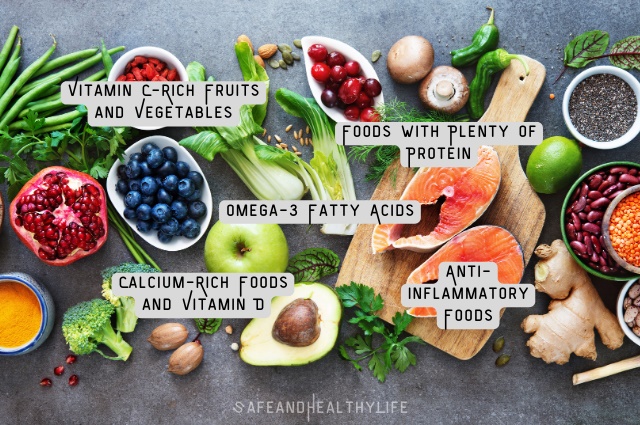
When our bodies are injured, they require specific nutrients to heal and repair damaged tissues. Including certain foods in our diet can speed up recovery and promote healing.
1. Vitamin C-Rich Fruits and Vegetables
Known as ascorbic acid, vitamin C is crucial in supporting the body’s immune system and aiding in healing.
- Supports collagen formation to help repair and strengthen damaged tissues
- Reduces inflammation
- Relieves pain
- Enhances iron absorption, which is crucial for hemoglobin production, a protein that carries oxygen in the blood
- Reduces oxidative stress
- Helps boost the immune system
The recommended daily value (DV) of vitamin C varies depending on age, sex, and life stage. The DV is the amount of a nutrient considered sufficient to meet the daily requirements of most healthy individuals. The recommended DV is typically expressed in milligrams (mg) per day.
Recommended DV of vitamin C for adults is as follows:
- Adult males: 90 mg per day
- Adult females: 75 mg per day
- Pregnant females: 85 mg per day
- Breastfeeding females: 120 mg per day
For children and teenagers, the recommended DV of vitamin C is lower:
- Infants (0-6 months): 40 mg per day
- Infants (7-12 months): 50 mg per day
- Children (1-3 years): 15 mg per day
- Children (4-8 years): 25 mg per day
- Children (9-13 years): 45 mg per day
- Teenagers (14-18 years): 65-75 mg per day
In some cases, higher doses of vitamin C are recommended for specific health conditions or during injury recovery to support the body’s healing processes. Always consult a healthcare professional for personalized advice on vitamin C intake.
Examples of vitamin C-rich fruits and vegetables include:
- Citrus fruits (Oranges, lemons, grapefruits, and tangerines)
- Berries (Strawberries, blueberries, raspberries, and blackberries)
- Kiwi fruit
- Pineapple
- Mango
- Papaya
- Red and green bell peppers
- Broccoli
- Brussels sprouts
- Spinach
2. Foods with Plenty of Protein
Protein plays a role in repairing and growing tissues such as muscles, tendons, and ligaments. Including foods rich in protein in your diet can contribute to expediting the recovery process.
- Enhances tissue repair and regeneration
- Supports collagen formation to help repair and strengthen damaged tissues
- Reduces oxidative stress
- Helps boost the immune system
- Reduces inflammation
- Relieves pain
Consuming protein-rich foods can provide the necessary building blocks for tissue repair and healing.
Excellent sources of protein are:
- Lean meats (Chicken, beef, and turkey)
- Fish (Salmon, trout, cod, and tuna)
- Eggs
- Dairy products (Greek yogurt and cottage cheese)
- Plant-based options (Chickpeas, black beans, and lentils)
- Soy products (Tofu and tempeh)
- Nuts and seeds (Almonds, chia seeds, and pumpkin seeds)
3. Omega-3 Fatty Acids
Foods rich in Omega-3 provide the necessary nutrients to recover faster. Omega-3 fats offer additional health benefits, such as improved heart and brain function.
- Reduces inflammation
- Relieves pain
- Improves blood circulation
- Supports collagen formation to help repair and strengthen damaged tissues
- Regulates and modulates the immune system
Sources of Omega-3 fatty acids include:
- Fatty fish (Salmon, mackerel, sardines, herring, and trout)
- Flaxseeds and flaxseed oil
- Chia seeds
- Walnuts
- Hemp seeds and hempseed oil
- Certain algae supplements (for vegan sources of DHA and EPA)
Considering Omega-3 supplements can also support injury recovery.
4. Calcium-Rich Foods and Vitamin D
Calcium and vitamin D are essential in supporting bone health and injury recovery. Together, they work harmoniously to promote bone healing and overall recovery.
- Provides the necessary building blocks to form new bone tissue and strengthen the healing site
- Promotes proper muscle function
- Vitamin D aids in proper calcium absorption from the intestines into the bloodstream
- Supports collagen formation to help repair and strengthen damaged tissues
- Reduces inflammation
- Relieves pain
- Regulates and modulates the immune system
Sources of calcium-rich foods include:
- Dairy products (Milk, cheese, and yogurt)
- Leafy greens (Spinach, broccoli, kale, and collard greens)
- Nuts (Almonds and Brazil nuts)
- Seeds (Chia seeds and sesame seeds)
- Fish (Salmon and sardines with edible bones)
Sources of vitamin D include:
- Sunlight (The body can produce vitamin D when the skin is exposed to sunlight)
- Fatty fish (Salmon, mackerel, and tuna)
- Eggs
- Fortified foods (Some dairy products, orange juice, and breakfast cereals may be fortified with vitamin D)
- Supplements (Vitamin D supplements are available if you have difficulty obtaining sufficient sunlight or dietary sources)
5. Anti-inflammatory Foods
When you sustain an injury, the body initiates an inflammatory response as a natural defense mechanism. While inflammation is essential for healing, excessive or prolonged inflammation can hinder recovery.
Anti-inflammatory foods can promote a more efficient healing process by:
- Modulating the inflammatory response
- Reduce inflammation
- Relieves pain
- Enhance tissue repair and regeneration.
- Regulates and modulates the immune system
- Reduce oxidative stress
Examples of anti-inflammatory foods include:
- Fruits: Berries (such as blueberries, strawberries, and cherries), oranges, pineapples, and papayas.
- Vegetables: Leafy greens (like spinach and kale), broccoli, tomatoes, and bell peppers.
- Nuts and seeds: Almonds, walnuts, flaxseeds, and chia seeds.
- Fatty fish: Salmon, mackerel, and sardines (rich in omega-3 fatty acids).
- Olive oil: Extra virgin olive oil is a healthy source of monounsaturated fats and contains anti-inflammatory compounds.
Discuss alternative options with a healthcare professional to meet your nutritional requirements if you have any food allergies or intolerances.
Regarding injury recovery, antibiotics are crucial in preventing and treating infections that may arise during healing. Combining antibiotics with foods that aid injury recovery can optimize the healing process.
A well-balanced diet of these nutrient-rich foods can significantly support the body’s healing process after an injury.
However, individual protein needs may vary based on age, sex, body weight, and activity level.
3. RICE Method
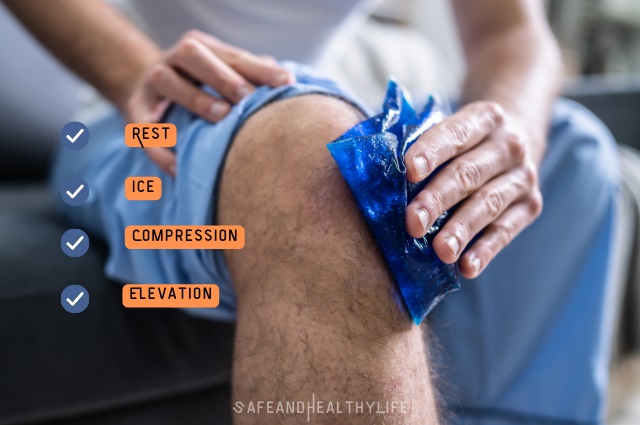
The RICE method is a commonly recommended approach for recovering from an injury faster using natural remedies. RICE stands for Rest, Ice, Compression, and Elevation.
Rest is essential to give the injured area time to heal and prevent further damage. Applying ice to the injured area helps reduce inflammation and swelling.
Compression, such as using a bandage or brace, can provide support and reduce swelling. Elevating the injured area above the heart helps minimize swelling by promoting proper blood flow.
4. Topical Treatments & Herbal Remedies
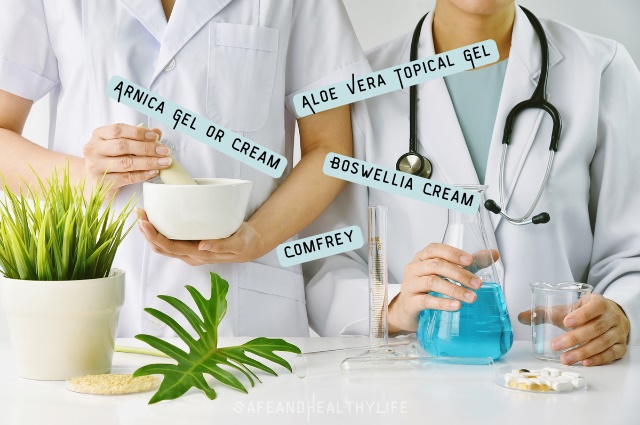
When recovering from an injury, topical treatments and herbal remedies help the body recover faster.
1. Arnica Gel or Cream
Arnica gel or cream is a popular topical treatment promoting faster injury recovery. Derived from the Arnica plant, this herbal remedy has been used for centuries in traditional medicine for its anti-inflammatory and pain-relieving properties.
Applying Arnica gel or cream to the injured area can help lessen the swelling, bruising, and discomfort that often accompany injuries like sprains, strains, and muscle soreness.
The natural compounds found in Arnica, such as sesquiterpene lactones and flavonoids, work harmoniously to promote blood circulation and alleviate inflammation, which supports the healing process.
Additionally, Arnica gel or cream is non-greasy and easily absorbed by the skin, making it a convenient and effective option for topical treatment.
2. Aloe Vera Topical Gel
Aloe vera has been used to treat various skin conditions and injuries. Its calming properties and ability to reduce inflammation make it an excellent option for accelerating the healing process after an injury.
Applying aloe vera topically can help relieve pain, reduce swelling, and decrease inflammation that often accompanies injuries like sprains, strains, and bruises. It also aids in the healing of wounds by encouraging the production of collagen, a protein involved in the creation of new tissue.
Furthermore, aloe vera can alleviate itchiness. Protect against infections by providing support for the healing process.
3. Boswellia Cream
This cream is a topical treatment that can be applied directly to the affected area. Boswellia cream can help reduce pain and swelling, promoting faster healing of injuries.
It’s often used to manage pain associated with sprains, strains, and joint injuries, as it can help soothe discomfort and improve mobility during recovery.
4. Comfrey
This herbal remedy has traditionally been used to heal wounds, sprains, strains, and minor fractures.
Comfrey products, such as ointments and creams, contain compounds that promote cell growth and repair, making them an effective remedy for injuries.
5. Essential Oils that Promote Healing
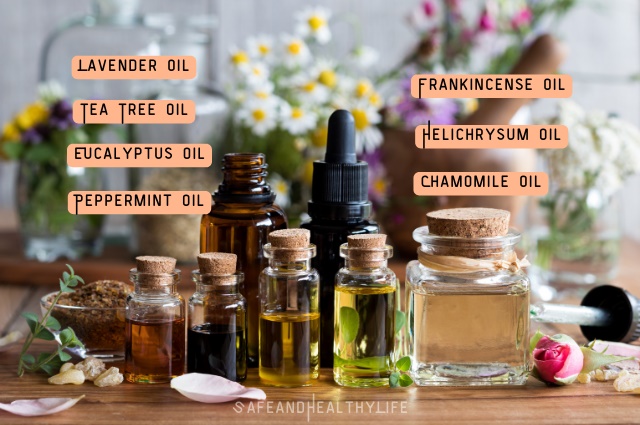
Derived from plants, these essential oils have been used for centuries to promote healing. These oils contain concentrated compounds with various therapeutic properties that support the body’s natural recovery processes.
Here are some essential oils that are commonly used to promote healing:
- Lavender Oil: It is well-known for its calming and soothing properties. It reduces stress and promotes relaxation, which can benefit the healing process.
- Tea Tree Oil: It’s recognized for its antimicrobial properties. It helps cleanse and protect wounds from infection, supporting the body’s natural healing mechanisms.
- Eucalyptus Oil: It has anti-inflammatory properties and helps ease respiratory issues, such as congestion, which can be helpful during the recovery from respiratory-related illnesses.
- Peppermint Oil: Peppermint oil help relieve muscle aches and pains by providing a cooling sensation to ease discomfort after an injury or physical activity.
- Frankincense Oil: Frankincense oil has anti-inflammatory and analgesic properties. It aids in reducing inflammation and soothing pain.
- Helichrysum Oil: Helichrysum oil supports tissue repair and regeneration, potentially useful for wound healing and skin-related injuries.
- Chamomile Oil: Chamomile oil is known for its calming effects and may help reduce inflammation and promote relaxation during healing.
When using essential oils, it’s crucial to do a patch test before applying them to a larger skin area to check for allergic reactions or sensitivities.
Additionally, essential oils should always be diluted with carrier oil before topical application.
Consult with a certified aromatherapist or healthcare professional before using essential oils, especially if you have pre-existing medical conditions or are pregnant or breastfeeding.
Proper usage of essential oils can complement injury recovery and promote overall well-being when incorporated into a well-rounded healing approach.
Final Words
Natural remedies have been used for centuries and offer a holistic approach to injury recovery. It has proven to be highly effective in promoting healing and reducing pain.
Whether using herbal remedies and essential oils or incorporating a healthy diet and lifestyle, natural remedies focus on healing the body from within.
By addressing the root cause of the injury and supporting the body’s natural healing processes, natural remedies provide a comprehensive approach to recovery.
So embrace the effectiveness of natural remedies to promote overall well-being and a speedy return to health.
Author Bio
Rick Kaselj is a highly respected health and fitness expert with over two decades of experience. He founded ExercisesforInjuries.com, OliviaDiet.com, Gentlestretching.net, Lifelongwellness.org, and HealthNewsDay.com, where he provides valuable resources on fitness, injury prevention, and healthy eating. Rick’s unique approach to fitness emphasizes targeted exercises and proper form, promoting long-term health and injury prevention. His expertise is showcased in his numerous books and training programs, which have helped countless individuals improve their physical health and well-being. Rick’s dedication to helping people achieve their health goals has earned him a reputation as a trusted authority in the industry.




